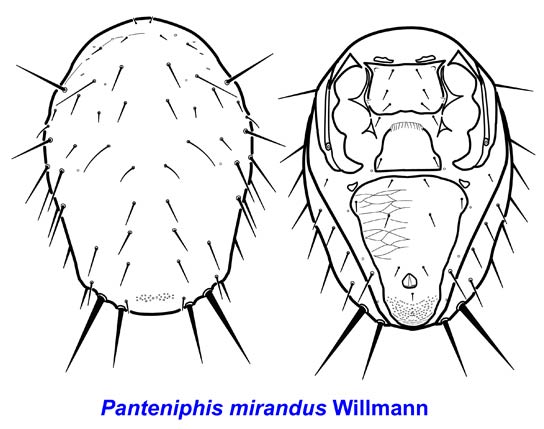| |
Panteniphis
Taxonomic
Position
Cohort Gamasina
Subcohort Dermanyssiae
Superfamily Rhodacaroidea
Family: Digamasellidae
Evans
Panteniphis
Willmann (=Lindquistoseius Genis, Loots &
Ryke)
Diagnostic characters:
-
Female with
3-4 pairs of setae on the sternal shield
(st1 in membranous or st4 off shield)
-
Dorsal shield entire in female (entire or divided in male; divided in
deutonymph); setae j1, z1 and j2 minute; scleronoduli
absent
-
Tibia I and genu I each with 5/3
or 5/2 dorsal/ ventral setae 12 or 11 setae total);
genu IV with 6 setae
-
Sperm
induction pore usually on leg III.
-
Tectum
with or with median subdorsal process and a pair of lateral tines
-
Deutonymphs phoretic on insects.
Similar taxa.
Species of Panteniphis appear to be aberrant Rhodacaroidea referable to
Digamasellidae because of their reduced leg setation and sperm induction pore on
leg III. Adults are strongly hemispherical in shape, but unlike somewhat
similar Dendrolaelaspis species, lack posterior horn-like processes and
have an entire dorsal shield.
Ecology & Distribution. Deutonymphs are phoretic on carabid
beetles. Adults are free-living in soil, Known distribution: Europe,
North America, and Africa.
References
Gwiazdowicz DJ.
2000. Description of deutonymph of Panteniphis mirandus (Acari:
Rhodacaridae) from Poland. Biologia Bratislava 55: 465-470.
Hurlbutt HW. 1975.
The systematic position of Panteniphis africanus (Acarina:
Mesostigmata). Acarologia 14: 36-42.
Kethley, J. 1983.
The deutonymph of Epiphis rarior Berlese, 1916 (Epiphidinae n. subfam.,
Rhodacaridae, Rhodacaroidea).
Canadian
Journal of
Zoology
61: 2598-2611.
Willmann C. 1949. Über eine
Milbenausbeute aus dem Naturschutzgebiet Verlorenes Wasser bei Panten (Kr.
Liegnitz). Abh. naturw. Ver. Bremen 32: 339-358.
